Edit: Spitfire Audio just announced the relaunch of one of their most successful library series:
Spitfire Symphony Orchestra. Originally released as the British Modular Library in multiple volumes around 10 years ago, the product line was consolidated over the years. A significant wave of fixes and
improvements was done in 2021 to simplify the product range and give even more value to the customers.
With their recent relaunch relaunch, Spitfire aims to push this process even further. The new 2024 Spitfire Symphony Orchestra consolidates all the Air Lyndhurst libraries into one package, offers a brand new interface using Kontakt 7’s new capabilities, fixes a lot of audio samples, and adds an advanced new
legato scripting created by Andy Blaney. All this at a heavily discounted price.
We updated our initial 2021 review of the Spitfire Symphony Orchestra to accommodate the features and concepts of the new 2024 version.
OVERVIEW
In this new iteration, Spitfire Symphony Orchestra has now become a complete set of
libraries covering all the orchestral instrument families: Spitfire Symphonic Strings,
Spitfire Symphonic Brass, Spitfire Symphonic Woodwinds, Spitfire Percussion (including
piano and harp), and Spitfire Masse, a clever set of instrument ensembles commonly
used in movie media.
All sections have been recorded at the famous AIR Lyndhurst Hall, one of the world’s largest recording facilities. Built from a converted church, and featuring peculiar acoustics controlled by a huge moving ceiling panel, it has been – and still is – used to record many famous scores over the last decades, including Gladiator, Harry Potter, How to Train Your Dragon, and many more.
Spitfire Audio’s goal in recording at Air Studios – hiring the same players used in these blockbuster productions – is to give composers a sample library capable of rendering convincing orchestral works for use in movies, TV, and video games.
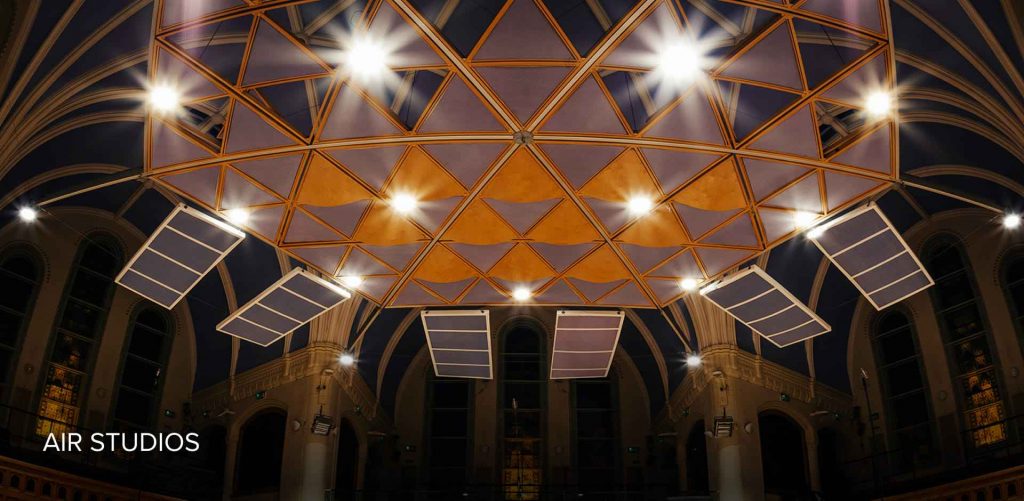
Spitfire Symphonic Strings features 60 players, including 16 first violins, 14 second violins, 12 violas, 10 celli, and 8 double basses. The library includes over 175 articulations comprising 94 longs, 59 shorts, and 9 legato types.
Spitfire Symphonic Brass includes French Horns, Trombones (Tenor & Bass Trombones), Trumpets, Tuba, Cimbasso, and even a Contrabass Trombone and a Contrabass Tuba. The sections were recorded with flexibility in mind, done both solo and a2 (two players in unison) for the majority of the instruments. Spitfire Symphonic Brass even features a6 patches for the Horns, Trombones, and Trumpets.
Similarly, Spitfire Symphonic Woodwinds features a comprehensive collection of the orchestral woodwind family, covering flutes (along with Piccolo, Alto & Bass Flute) and clarinets (along with Bass & Contrabass Clarinets), complemented by the oboe, cor anglais, bassoon, and contrabassoon. Here again, the players were recorded as solo and a2 sections for most of the included instruments, which can then be combined to create an a3 section for example.
Finally, Spitfire Masse contains layered ensembles from the three libraries, covering strings, brass, and woodwind sections, along with a tutti. Each ensemble features several distinct “themes”, which correspond to various playing techniques assembled for a massive and cinematic sound.
Spitfire Percussion, performed by the renowned Joby Burgess, features 9 tuned, 13
drums, 12 ‘toys’, 14 unpitched metal, and 3 unpitched wood instruments. Also included in
this section are the orchestral piano and harp.
All sections of the libraries have been recorded in situ (at their standard position in an orchestral seating). This is particularly important when you want to combine sections recorded in a nice reverberant room such as the Lyndhurst Hall, in order not to disrupt the spectral integrity. A new selection of distinct microphone signals has also been chosen for this relaunch, which we will talk about later on in this review.
The whole content of the sample library has been consolidated in a tighter, more balanced package, requiring a total of 345 GB after installation. The library runs under Kontakt 7 but is compatible with
the free Kontakt Player as well.
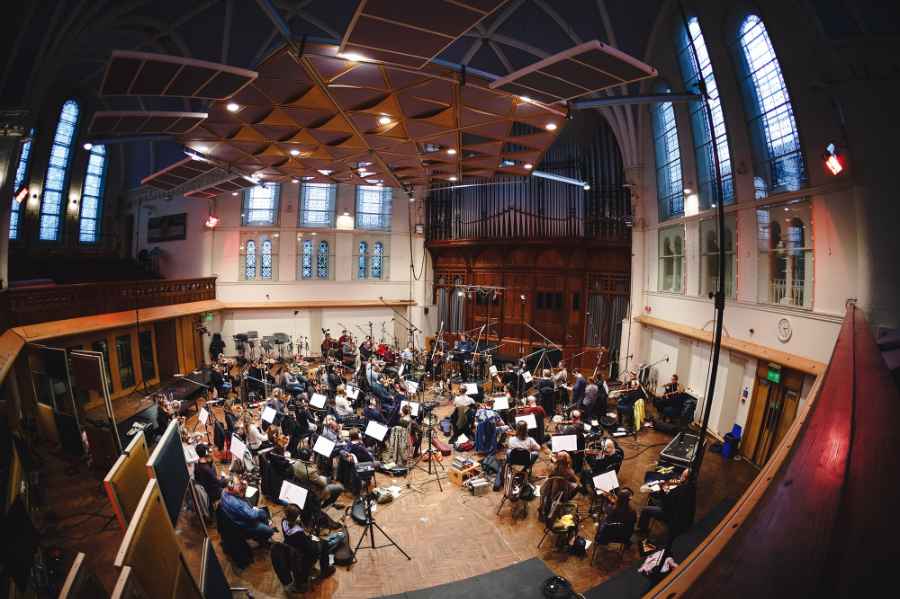
INTERFACE
One of the most obvious changes users will notice is the new interface. While the previous interface was as functional as it could be in its very compact format, the new one looks much more sleek and modern, taking ample screen estate to create a visual identity of its own. Using Kontakt 7’s graphic capabilities, it introduces a new colour palette and expands to a comfortable size that emphasizes the most important controls.
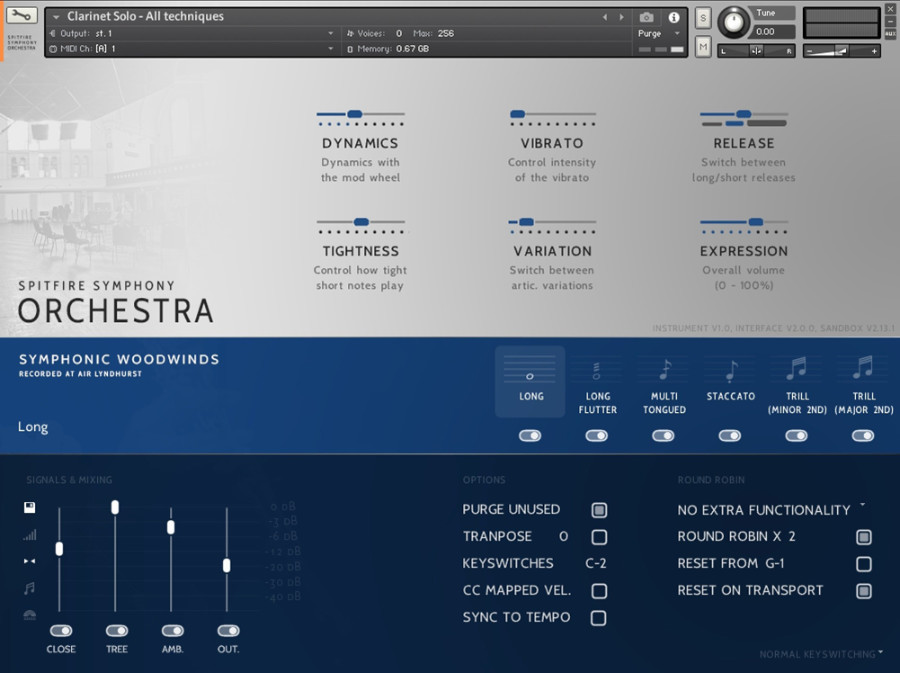
The top of the screen includes the three most commonly used controls: dynamics, vibrato, and expression. Depending on the patch, tightness, release, and variation control are also present. All these controllers are assignable in many ways (to CCs, keyswitches, etc). The technique selection lies in the center of the screen. The bottom part features microphone signals and various options related to mixing, stereo width, playing response, and round robins.
ARTICULATIONS
As soon as you open Spitfire Symphony Orchestra in the Kontakt browser, you can immediately see the impressive number of articulations and playing techniques included.
These are organized into the four main orchestral sections, while two additional folders exist for individual techniques and legacy patches (Spitfire decided to include some of the previous patches in this edition for added flexibility). Within the four main sections, the patches are further divided into “All techniques”, “Core Techniques”, “Decorative Techniques” and “Performance” (i.e. “Performance Legato”, more on this below).
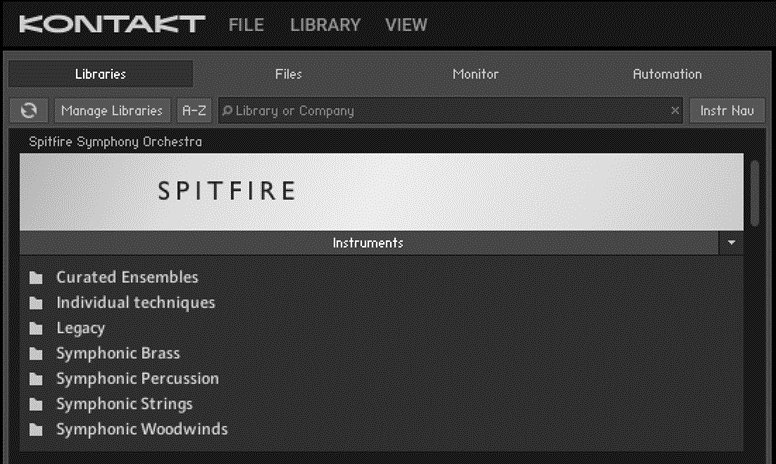
Looking deeper into the content, we can see that Spitfire Symphonic Strings has the largest amount of patches of all three main libraries. The string section’s long articulation patches are beautifully recorded and show Spitfire’s dedication to offering a truly cinematic-oriented sound. From Normale, Flautando, to Con Sordino, the sampled articulations represent an excellent palette of different techniques and textures to choose from.
A lot of these textures are, in fact, very relevant in today’s music for media. Our favorites among these textural patches include the Con Sordino Blend, Flautando, Harmonics, and Super Sul Tasto. Most of these patches offer several dynamic layers, as to be expected. Where appropriate, you have access to two to three vibrato layers, ranging from non-vib to molto vib. Half-note and whole-note Trills as well as Tremolos have also been sampled all across the string sections.
There are nine dedicated string legato types included. The first five are found in the standard legato patches: Bowed, Fingered, Portamento, Runs, and Sul G/C.
The other four are found in the Performance Legato patch. Available for the brass and woodwind sections as well, these Performance Legato patches automatically adapt to our playing speed and switch between different articulations and legato techniques accordingly. This makes it possible to write an entire musical phrase within the same patch, from short spiccatos to slow lyrical legato lines.
As of note, in this new version of the Symphony Orchestra, Spitfire Audio addressed a common request: they added the missing intermediate vibrato layer to the legato patches, giving us access to the full expressivity of the recorded samples. The legato transitions have also been reworked and now crossfade much smoother, bringing them in line with more recent Spitfire Audio releases.
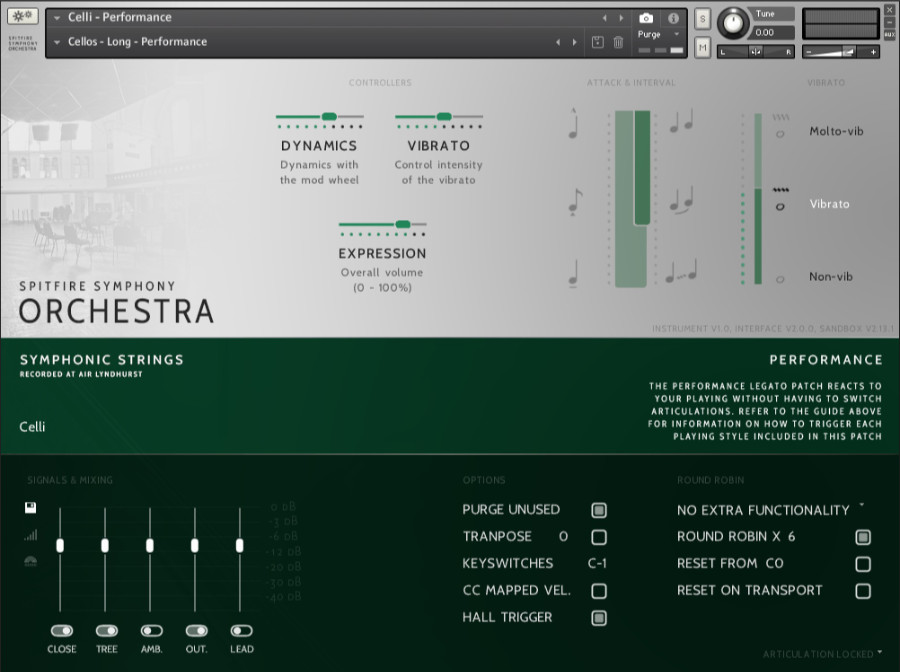
The string section’s short articulations are numerous and include Spiccatos, Short Brushed, Pizzicato, Short CS, and more. They are distributed coherently across all the sections. The different Brushed Shorts and Pizzicati are particularly beautiful and really show the quality of the hall in their lush release tails.
Instead of sampling Marcato and Staccato techniques, Spitfire Audio preferred to opt for so-called Short 0’5 and Short 1’0 articulations that vary in length. The number refers to the length of the recorded sample. These two articulations were captured in p/m/f, and their attack is controllable with a Tightness slider. We would have preferred to see proper staccato and marcato articulations though, as we feel the end result sounds more like a compromise between the two, even with the Tightness slider set fully to one side.
Overall, the same comments apply to the woodwind section. In our tests, the woodwinds were a particularly good match for the strings, and the sound of the AIR Lyndhurst Hall yielded beautiful results. The fact that the library is offering solo and a2 patches adds a lot to its flexibility. The woodwind recordings are indeed very expressive and suit emotional statements as well as orchestral accompaniments.
It is nice to see that the long techniques allow for a certain amount of vibrato control, scaling from non-vib to vib. The woodwind runs presented in Spitfire Symphonic Woodwinds sound particularly good, too.
Moving on to the brass section, here again, Spitfire Audio offers patches both in solo and a2, and even includes a6 ensembles for Trumpets, Horns, and Trombones. This provides the brass section with a great deal of tonal flexibility. The sampled dynamic range sounds to be around piano (p) to fortissimo (ff), which nicely represents the traditional orchestral dynamic range. Cuivre and bells up performances are also included, to provide more timbre variations. The a6 ensemble patches in particular are truly powerful and the low brass resonates well in the recording hall.
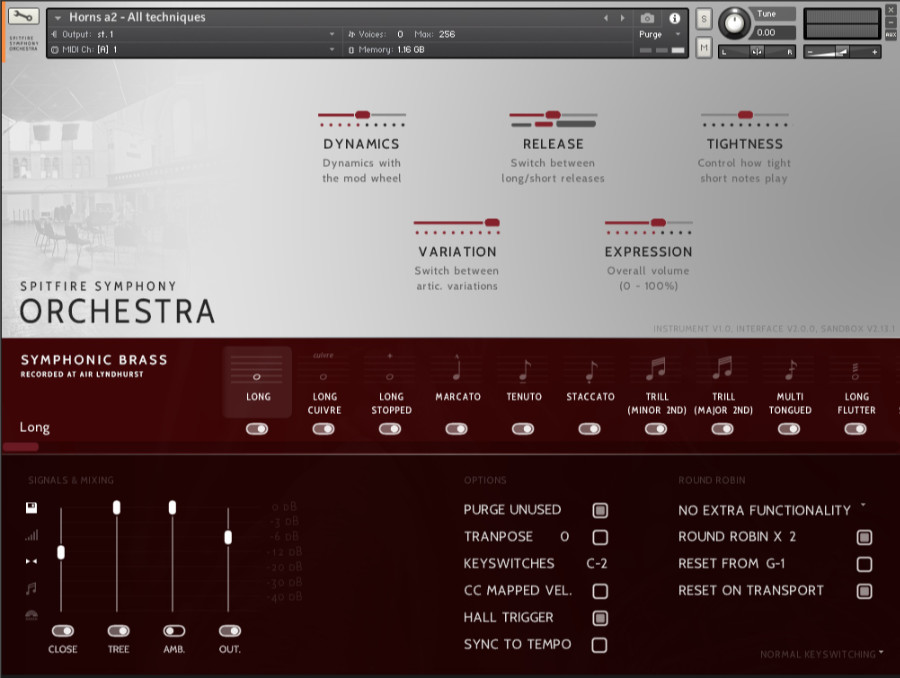
The lower dynamics and mellow registers are sampled exceptionally well. If there is anything to criticize for us, it would clearly be the absence of legato articulations for the solo Trombone (a feature that was announced for a future update a few years ago). Anyway, to keep a sense of proportions, these minor flaws would not necessarily be obvious in the context of a full musical piece.
Next is the percussion instrument family. This section used to be covered by a separate product (Spitfire Percussion) but is now included in the Spitfire Symphony Orchestra package. The range of percussive instruments covered is astonishing, ranging from thuderous timpanis to delicate glockenspiels. The percussion section even includes unusual percussive “toys”.
All performances are very well recorded and respond superbly to the Air Lyndhurst Hall. An orchestral piano and a harp are now also part of the range. While the piano is functional in context, the harp is a highlight and able to deliver fragile and delicate performances that work well within the room.
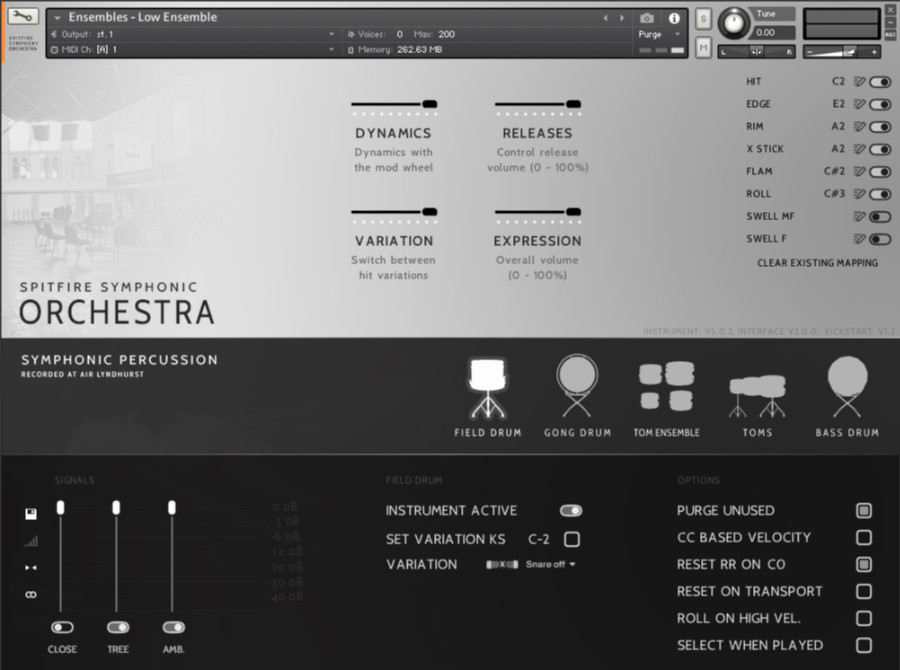
Similarly, the library previously called Spitfire Masse is now labeled “Curated Ensembles” and became part of the Symphony Orchestra package. It contains pre-orchestrated and pre-mixed sections, that allow for great ease of use and maximum impact. The available patches cover the strings, brass, and woodwind sections as well as all sections playing together as Tutti. They are programmed using several dynamics and vibrato intensities. Among those patches, some of our favorite ones are the Cool Strings, the Ligeti Strings, the Woodwind Chorus Long, and Orchestrator Longs, with an honorable mention to the Brass Beast Shorts. Overall, these curated ensembles are a really useful tool to quickly sketch ideas with convincing, cinematic colors, or as an additional layer to give the main three libraries even more gravitas.
MICROPHONE MIXES
The 2024 iteration of the Spitfire Symphony Orchestra features a new, balanced set of microphone signals. Although there are slight differences within the library, the set revolves around the well-known CTAO combination: Close, Tree, Ambient, and Outriggers signals. Some of the sections have an additional signal: a leader microphone in the strings section for example. This overall reshuffle involves the loss of the previous ready-to-use stereo mixes but also streamlines the microphone array. Given the hard drive space these numerous signals take, Spitfire Audio had to make a difficult choice here, as they undoubtedly wanted to offer a cheaper, lighter package. Having said that, the CTAO combination was also a staple in previous Spitfire products and is very easy to balance.
The advantage of the new programming is that all the signals are available within a single patch, contrary to the previous edition of the orchestra.
To review these different signals in detail, we transcribed a part of the main title of The Queen’s Gambit, composed by Carlos Rafael Rivera. All the examples below were created using out-of-the-box patches that feature just one microphone signal at a time. No panning and no additional reverb were applied, just a limiter was added to the mix bus for some quick gain staging.
CLOSE MIC
The Close (C) mic is useful to add definition to musical lines while offering a rather narrow stereo image. Since the hall the samples were captured in is very reverberant, the Close mic still retains a healthy amount of roominess. The resulting sound is focused on the players and adds a lot of detail and presence to the mix.
TREE MIC
The Tree (T) is a signal taken from a so-called Decca Tree microphone array, placed above the conductor of the orchestra. This results in a balanced representation of both the definition of the instruments and the recording hall’s sound. Compared to the Close mics, you can hear a clear and wider stereo image.
AMBIENT MIC
The Ambient (A) mics, placed further away from the orchestra, are more about the ambience and acoustics of the hall. The stereo imaging is a bit less focused as the reverberance of the room becomes far more prominent. While it isn’t a mic position we would use on its own, it is very useful in combination with other more defined mics, in order to make the orchestra sound bigger and wider.
OUTRIGGER MICS
The Outriggers (O) having significantly more distance between each other than the Tree, offer a very wide, almost separated, stereo image at the expense of a bit of definition. They are a great fit for strings and brass in cinematic music, as they leave a sonic space in the middle for dialog.
When it comes to using these mic signals, the Tree makes for a good starting point. If you then add one or two other signals between -6 and -3 dB in volume you will usually be able to create an excellent overall sound. Depending on the desired sound of the music, you can also add some Close mic to emphasize the intimate details and liveliness or go with a bit of Outriggers/Ambient to enhance the stereo image and depth.
CONCLUSION
With this relaunch of the Spitfire Symphony Orchestra, Spitfire Audio further refines one of its most classic and timeless libraries. All the sections share a great tone and a wonderful hall ambience, as many existing users will already know. They also have an excellent array of articulations – in particular the long ones which allow composers to build a wide range of intricate orchestral textures.
Spitfire Symphony Orchestra makes for a very solid orchestral palette, particularly if the quality and color of the hall ambience is a point of consideration. While the absence of the ready-to-use stereo mixes is regrettable, the revised microphone array is well-balanced, in particular for media composers who have to dial in sounds quickly. The reduced price (a little over a third of the original price) and streamlined size of the whole package are also clear highlights.
The recording quality, sheer number of articulations, and the new price point all contribute to presenting Spitfire Symphony Orchestra with one of the best quality-to-price ratios in the market today.
Pros
- New Performance legato scripting
- Smooth legato transitions
- Great hall ambience
- Solid and balanced microphone array
Cons
- Some inconsistencies in the selection of techniques across the woodwind sections
- The RAM-efficient stereo mixes were scraped in the 2024 version
RECOMMENDED: 9/10
The Spitfire Symphony Orchestra is available for €569 through Spitfire Audio’s online shop. If you already own Symphonic Woodwinds, Symphonic Brass, Symphonic Strings, and Spitfire Percussion, you will receive Spitfire Symphony Orchestra completely free of charge. Combinations of other owned products featured in this library will still entitle you to a special upgrade pricing for Spitfire Symphony Orchestra.
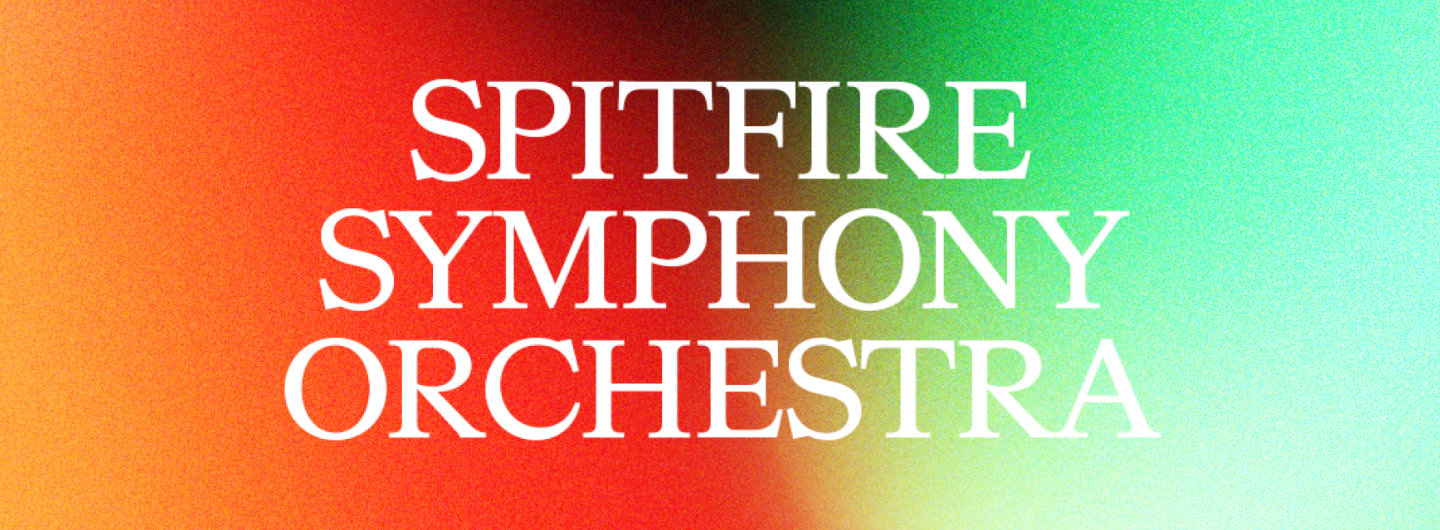

2 comments on “Spitfire Audio – Spitfire Symphony Orchestra (Review)”